Marketing Spotlight: Analyzing Craft.co’s social media and content marketing strategy
Article summary
Share
In this article we examine Craft.co’s marketing and sales strategies, focusing on social media and content marketing, as of November 2024.
This is part of our Marketing Spotlight series, designed to help & inspire marketers by showcasing companies doing an amazing job at marketing.
(P.S. Need help? Send us a message, we have Milk & Cookies and good strategies ready)
📝 A quick note before you start reading:
The data and analysis in this article are valid as of the time we wrote it. We don’t know when you’ll be reading this, maybe next week, maybe six months from now, and things might have changed since we looked at this company’s marketing and sales approach. Still, the insights and lessons here stay useful, even if the numbers or tactics have evolved a bit.
This article is a bit longer than a typical post, but we believe the insights and B2B digital marketing strategies you’ll discover are well worth the time.
Overview
Craft.co is an supply resilience platform, offering 360-degree supplier network visibility, AI-driven insights to manage disruptions, and collaborative tools to optimize supply chains.
Founded in 2014 and based in San Francisco, CA, USA, their mission, as stated by CEO Ilya Levtov, is “to make global supply chains more resilient”.
Ergo, let’s start with the analysis of Craft.co’s social media presence and after that we will conclude with their content marketing tactics.
The Strategies behind Craft.co’s social media presence

Craft.co’s primary social channel is LinkedIn, where they have 8,000+ followers and 125 associated members, mostly engineers and business development professionals. The median employee tenure is 2 years, reflecting either dynamic growth or turnover.
What are their main content pillars?
Platform Promotion:
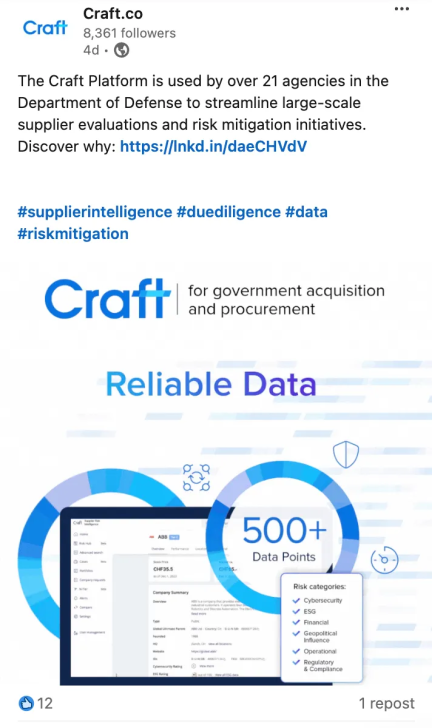
Targeted posts focus on procurement professionals, especially in government agencies and large organizations that require supplier evaluation processes. These posts include clear calls-to-action (CTAs) like “Discover why”, linking to resources page gated behind business email forms, a classic lead generation strategy.
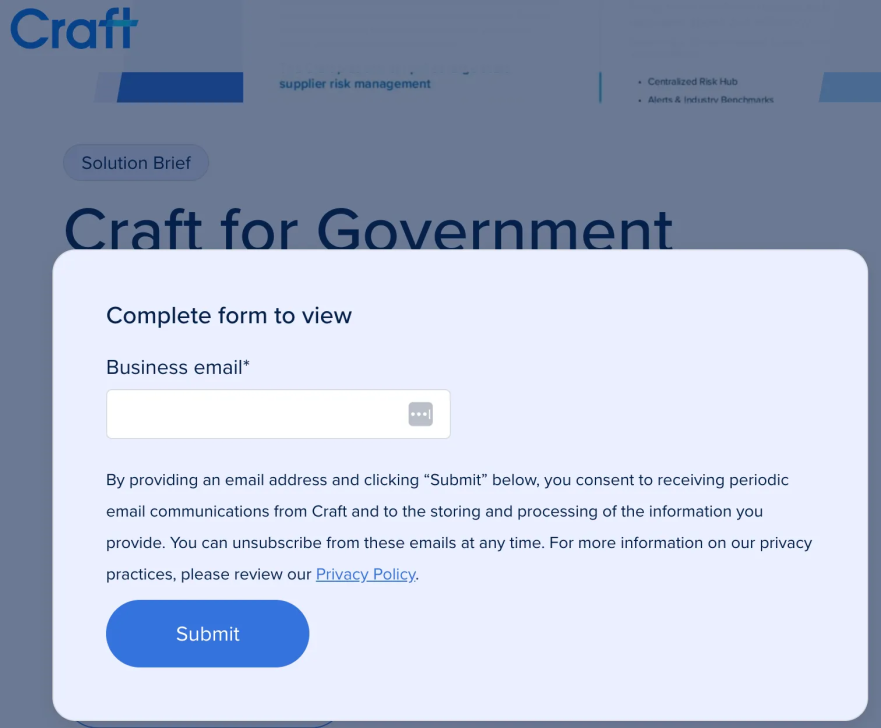
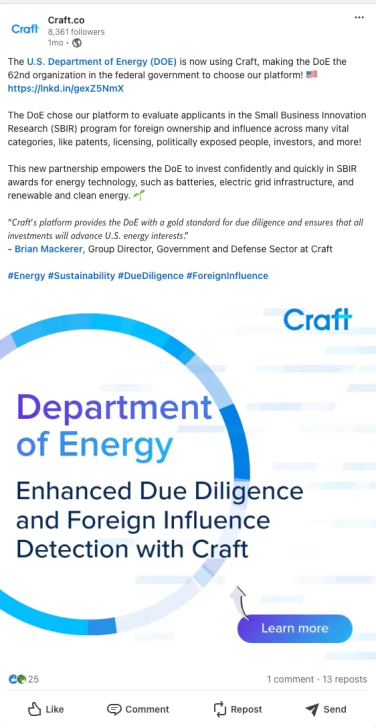
Industry news sharing:
Craft.co shares relevant industry updates, positioning their Supplier Risk Management platform as the solution. For instance, posts about EU technology transfer regulations emphasize how their platform helps businesses improve supplier visibility and resilience.
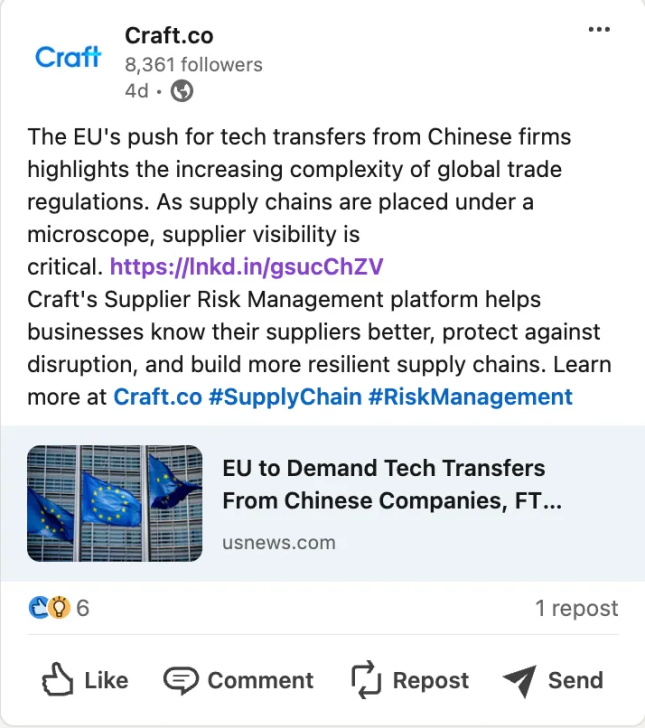
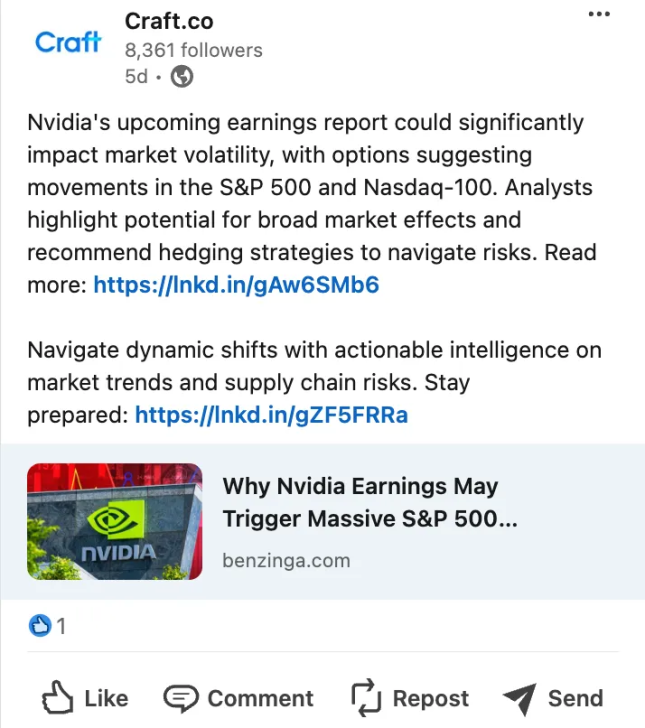
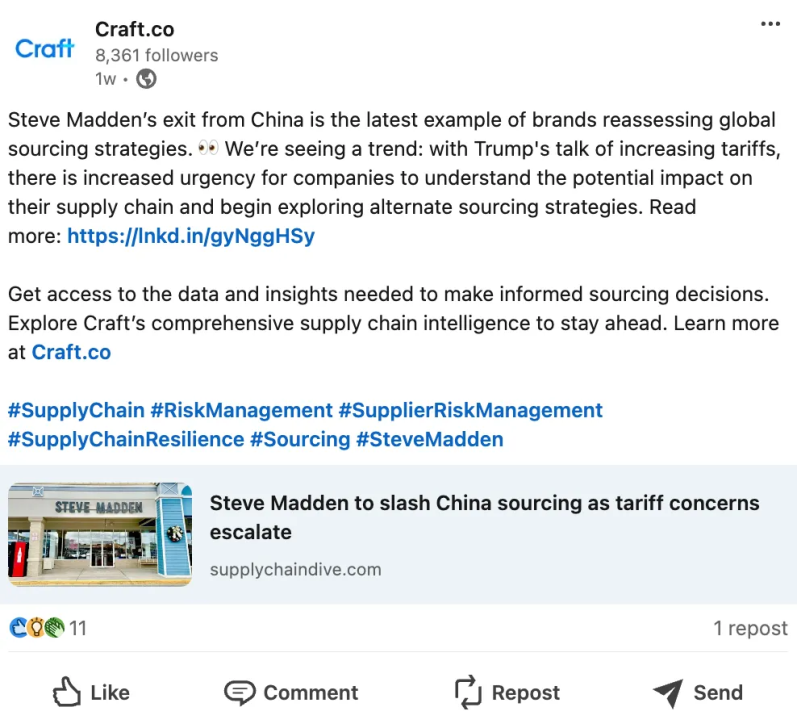
Event promotion:
Craft highlights live events on topics like supplier sustainability, reinforcing their role as advocates for sustainable supply chains. They also spotlight CEO Ilya Levtov through interviews with procurement publications, like SupplyChain247, boosting company credibility and thought leadership.
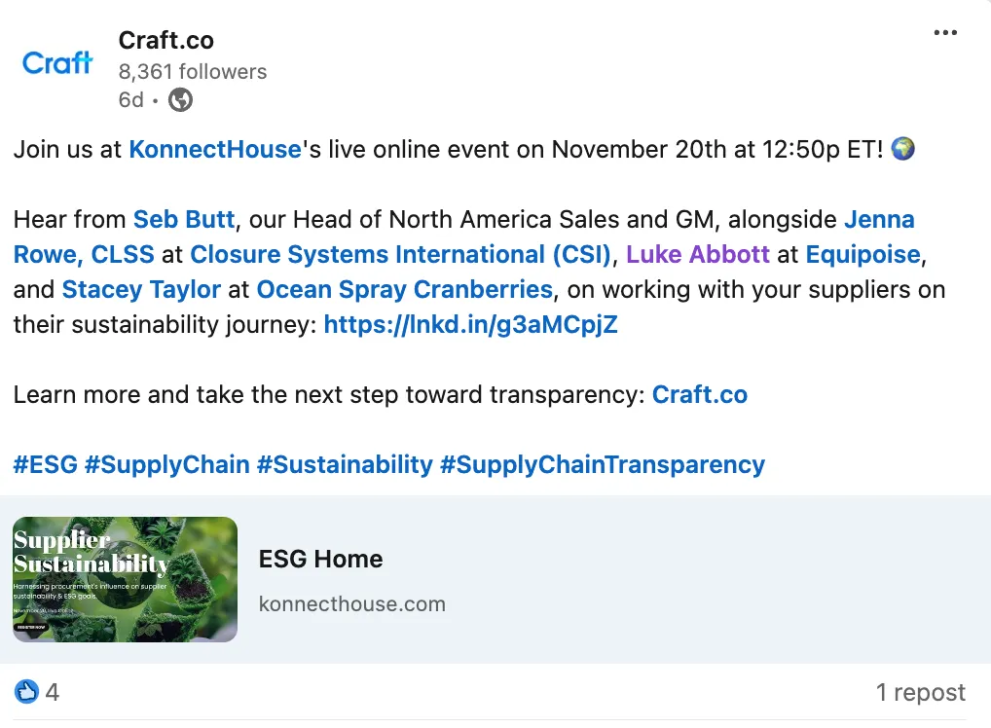


Visual content:
Some posts feature a carousel with data snippets, also gated behind email forms. Infographics are used to engage viewers visually, a proven method to enhance content retention. However, viewers must visit the website and submit a business email to access detailed infographics.
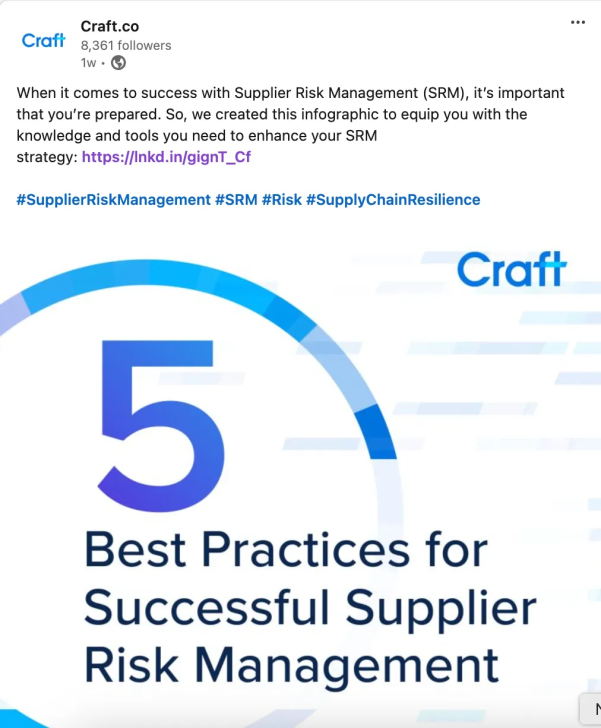


Press releases:
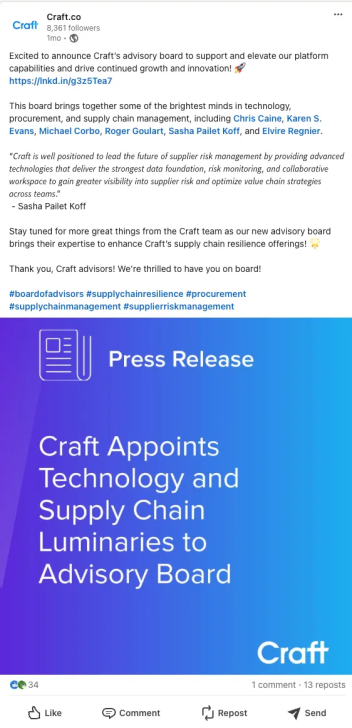
Educational content:
Craft.co shares informative content covering supplier risk management, sustainability, and supply chain intelligence, positioning Craft as an expert resource.

How often do they post?
They posts on an average 13 times per month, but engagement is modest, with most posts earning fewer than 30 likes, and rare comments. This is a clear opportunity to improve interactions with key opinion leaders and communities, to improve the results via the algorithms. Formats include text combined with images, carousels, and polls, though video content appears minimal.

Common hashtags such as #SupplyChain, #Sustainability, and #RiskManagement organize content and (probably) increase visibility, although most experts (and we can confirm from our experience working with clients such as Veridion & Hermix, two kind of similar clients that we help grow their social media and digital marketing footprint, hashtags kind of don’t work to increase visibility and reach.
Posts routinely include CTAs encouraging discovery, event registration, or resource downloads, driving followers to their website and capturing leads.
Craft.co’s Facebook page has been inactive for the past two years (1.2k followers), and their X(ex-Twitter) account is inactive for 1 year, offering little opportunities to analyze.
Leadership Presence
Ilya Levtov, CEO

The CEO of Craft.co has 500+ connections on LinkedIn, with the last original post dated a month ago, as of November 2024. His posts primarily consist of resharing content rather than original thought leadership, with engagement between 35 and 60 likes, and no comments. While this is a missed opportunity for deeper audience interaction, the celebratory posts where he highlights team achievements and company recognition help build brand image.
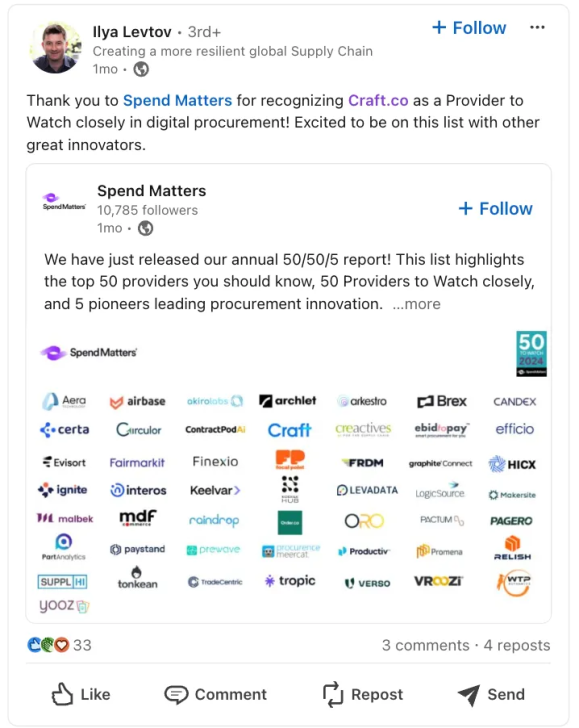
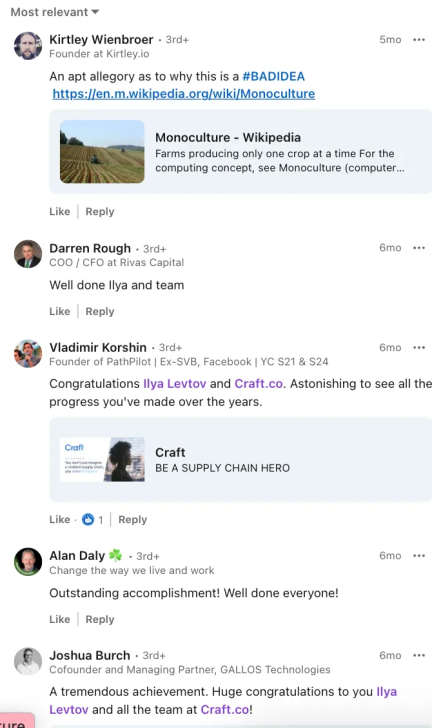
When a CEO highlights achievements, such as being named a Value Leader, it also improves the company’s public image. It positions the organization as a leader in its field, attracting potential clients and talent.

Ilya Levtov is engaged in creating technology trends content, which positions himself as an industry leader.
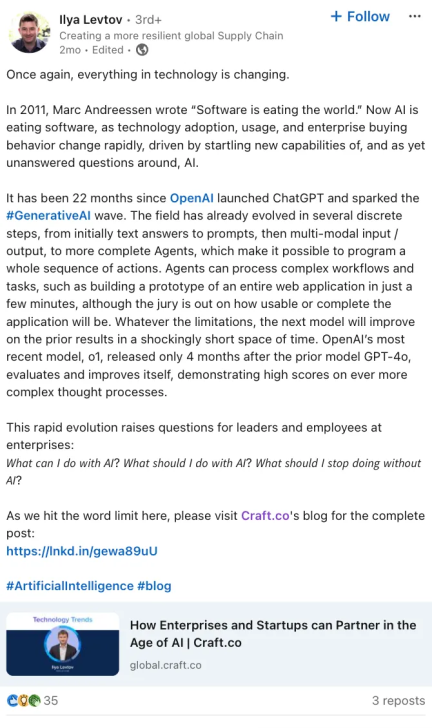

Mimi Spier, CMO

Similar to the CEO, the CMO of Craft.co posts about once a month, mostly resharing content with some original commentary. She engages occasionally in comments with social selling tactics. Her posts also promote company partnerships and achievements. However, overall engagement remains low, with the top post having 41 impressions in the last 3 months.




Both leaders could leverage the consistently updated blog content more actively to boost company visibility and lead generation. However, neither currently seems to be focused on creating demand for the company’s services through their LinkedIn presence.
But all in all, we believe they are doing an amazing job at creating brand awareness and positioning the company.
The analysis of the strategies behind Craft.co’s content marketing
Landing pages
Request a demo

This landing page is designed to capture leads by inviting them to try Craft’s platform. To proceed, users are asked to provide their business email, the number of suppliers, and any relevant comments or notes.
The form is clean and straightforward, focusing only on the essential information. The dropdown for the number of suppliers is particularly useful, as it helps qualify leads based on their business size and needs.
The comment section is a smart addition, giving prospects the opportunity to share their pain points, challenges, or goals. This input can be used to tailor the demo experience, making it more personalized, increasing the chances of converting leads into customers.

The content on this page is strong and effective, by clearly stating the benefits like “elevate your supplier risk management strategies” and “experience the power of Craft firsthand”, used to reduce buyer’s friction.

This approach helps qualify leads by providing clear value upfront. Users who click through are more likely to be interested in the product, which can lead to higher conversion rates. Adding this level of context ensures the page attracts traffic and the right audience ready to engage.

We also noticed that their CTAs are quite long and explainable, like: “Sign up for a demo today and discover how you can elevate your supplier risk management strategies.” or “Request a demo today to experience the power of Craft firsthand.”
Although explaining the user’s benefits and providing context will lead to higher conversion rates, long CTAs can be harder to read quickly, especially on mobile devices.
Their copywriting also includes three aspects of their product: Superior Data Fabric, Collaboration and User Friendly.
Each aspect of Craft’s offering is explained in detail. For example, they position their data fabric as “rich” with “unmatched data breadth and depth,” showing a “meticulous validation process” to ensure accuracy and reliability.
The detailed explanations serve multiple purposes:
- Differentiation: features like “unmatched data breadth” sets Craft apart from competitors who may offer less comprehensive solutions.
- Credibility: Providing clear, in-depth descriptions builds trust, as it shows Craft’s expertise and attention to detail.
- Problem-Solution Mapping: By addressing common pain points, these explanations show how Craft solves challenges faced by supply chain professionals.
By mentioning the “meticulous validation process” for their data, Craft.co is directly addressing a critical concern in the industry: data reliability. This is particularly important in supply chain management where decisions based on inaccurate data can have bad financial implications.
Risk Assessment

To get a Risk Assessment, leads are required to provide their business email, job role, company size, and any comments they wish to add. However, the only mandatory field is the business email. The goal is to capture leads and ensure follow-up opportunities. They are keeping the other fields optional, making the process simple and lowers the barrier for initial engagement, while still collecting enough information to qualify potential prospects.

The page features a strong call-to-action: “Schedule your FREE Supplier Risk Assessment today.” This acts as a lead magnet, drawing in potential customers with the promise of value at no cost.
“Speak with our team of experts” adds a personal touch, indicating that users will be able to discuss their specific challenges with knowledgeable professionals. This reinforces the idea that the advice provided will be relevant and tailored to their unique circumstances.
The goal of this landing page is clear: to generate leads by capturing contact information from interested prospects.
Resource center
Craft.co offers gated assets like solution briefs, white papers, webinars, and e-books, all requiring business email to download. These demonstrate thought leadership and provide strong lead magnets.
Solution brief
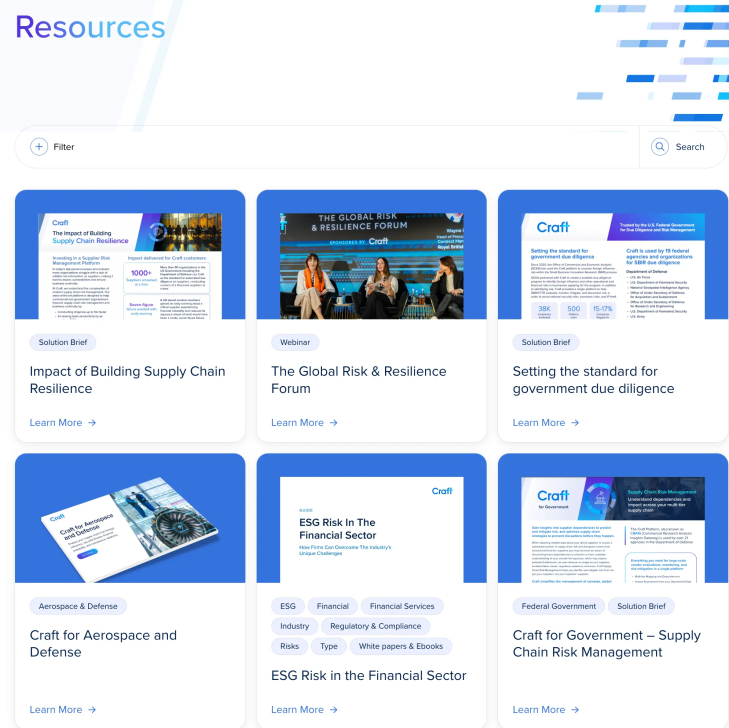
Solution brief pages are basically case studies and to access, the leads have to download them by providing their business address. The form asks for specific information like job role and company size, allowing Craft.co to qualify leads and tailor their follow-up communication.

This is a strategy to capture leads for their newsletter. Compared to scheduling a demo, downloading a Solution Brief is a smaller commitment for leads, potentially increasing conversion rates.
Whitepapers & E-books
Their white papers and E-books have the same strategy as their Solution Brief.
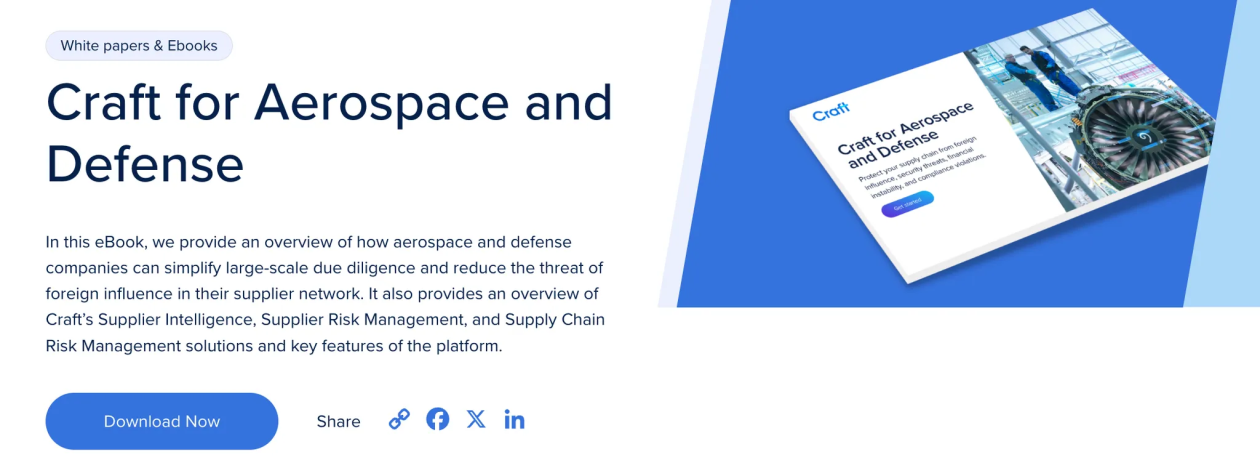
White papers are a powerful form of content for several reasons, particularly in thought leadership, because white papers can position brands as industry experts. According to the Edelman-LinkedIn B2B 2024 Report, 52% of decision-makers and 54% of C-suite executives spend an hour or more each week consuming thought leadership content. This highlights the strong demand for high-quality, insightful material.
White papers are a go-to resource for B2B buyers. Research cited in Forbes shows that 82% of B2B buyers rely heavily on white papers, along with webinars (78%) and case studies (73%), to inform their purchasing decisions.
Blog page
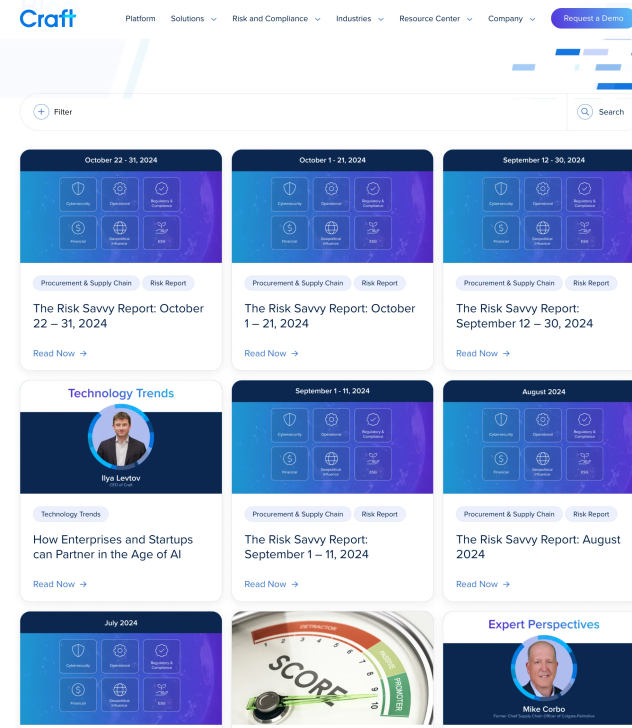
The “Risk Savvy Reports” blog series publishes 1-3 articles monthly, featuring industry insights and posts by executives. Each post encourages newsletter subscription, which serves as another lead magnet offering timely supplier risk insights across a range of topics like regulations, technology, cybersecurity and ESG. The newsletter is prominently promoted on multiple pages to attract and engage subscribers.


Their reports are actually a collection of news on different topics.
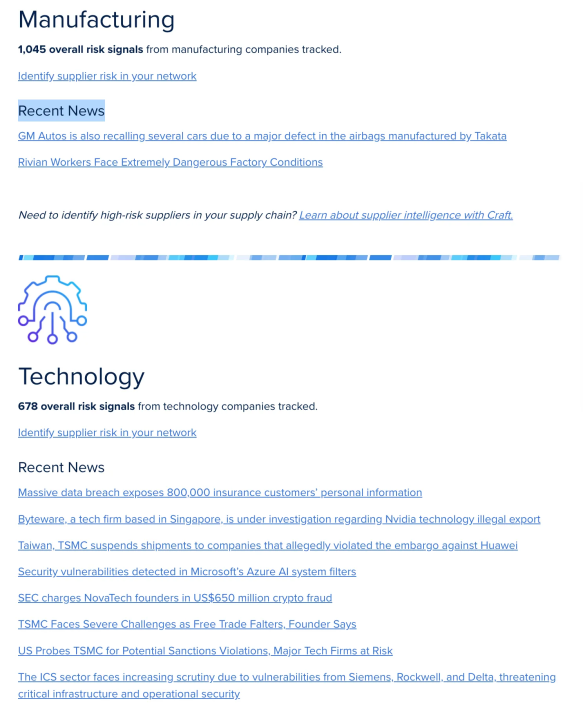
At the end of a blog page, they have the CTA: “We hope these insights have enhanced your understanding of supplier risk in the global supply chain, making you evermore risk savvy. Subscribe to our newsletter for more insights.”
At the bottom of the page, we see some recommendations of related posts.
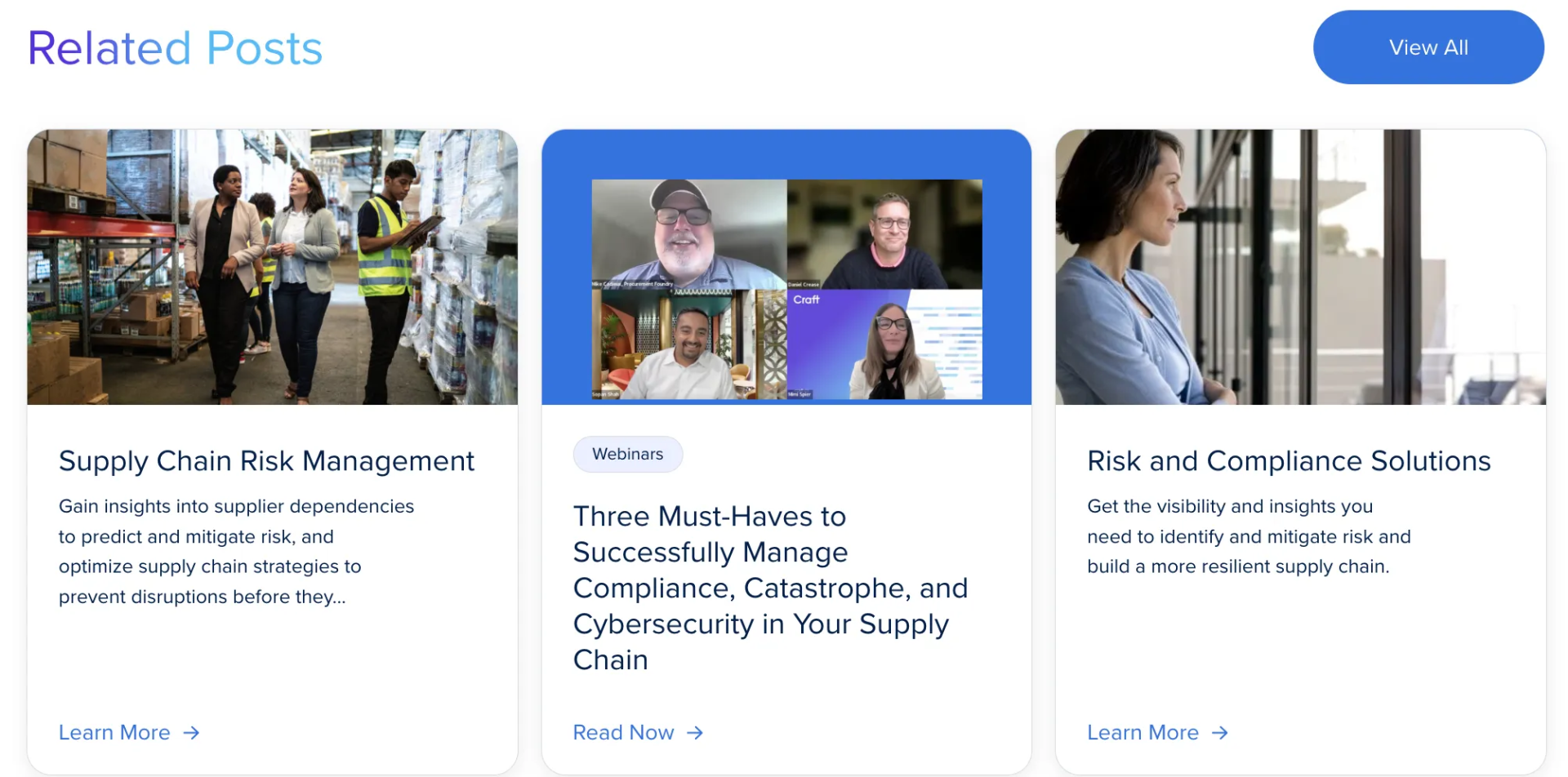
Newsletter
As we saw in the other examples above, they put a lot of focus on their newsletter. You can find the page at the bottom of their main page.

This newsletters is a lead magnet. It serves to attract potential customers and build a subscriber base. Craft.co’s newsletter promises “360-degree visibility, timely insights, and agility” in supplier risk management, offering valuable information that can help organizations improve their operations.
Regular newsletters keep subscribers engaged with Craft.co’s content, increasing the chance for actually opening the emails and interacting with future communications. Higher engagement rates are important for nurturing leads into customers.
They also have a landing page for the newsletter:

They made a smart move by explaining why should someone subscribe to their newsletter, because it can make a difference between being seen as a trusted source of information or ending up flagged as spam over time.
The phrase “Gain advantage with valuable content” communicates the benefit of subscribing. It promises insights that can help readers stay ahead in their field, which is a strong motivator.
By mentioning topics like “regulations, technology, cybersecurity, geopolitics, ESG, and more,” explains how much information subscribers can expect to receive. This wide range of subjects makes the newsletter appealing to a diverse audience interested in different aspects of supply chain management.
Also, mentioning “latest trends” and “news impacting the global supply chain” positions the newsletter as a timely resource. This shows how relevant it is and how attentive and responsive they are to current events, making it more appealing to subscribers who are looking for up-to-date information that can help them navigate their industry.
Webinars
Craft.co’s webinars are also gated and can be accessed with the business email. Apparently, they love gated content, rarely offering something for free. At this moment, they have 6 webinars on their page.
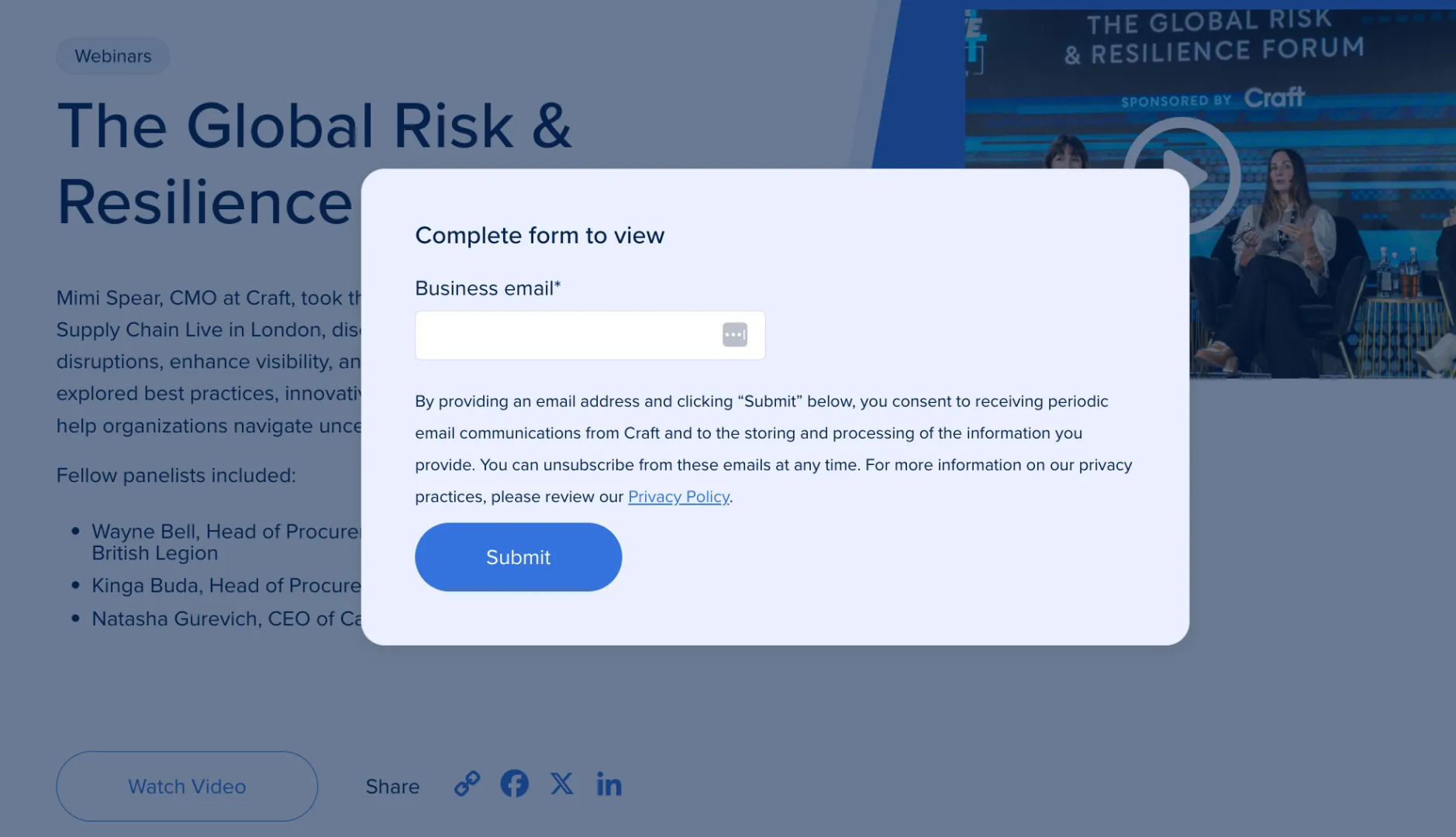
Craft.co’s Paid Advertising Strategy
On LinkedIn Craft.co ran 387 ads, as of November 2024, with their last campaign running from 1 October to 1 November 2024. The total impressions of ads range from 1k-5k. The United Kingdom and United States are the countries most receptive to Craft.co’s ads.
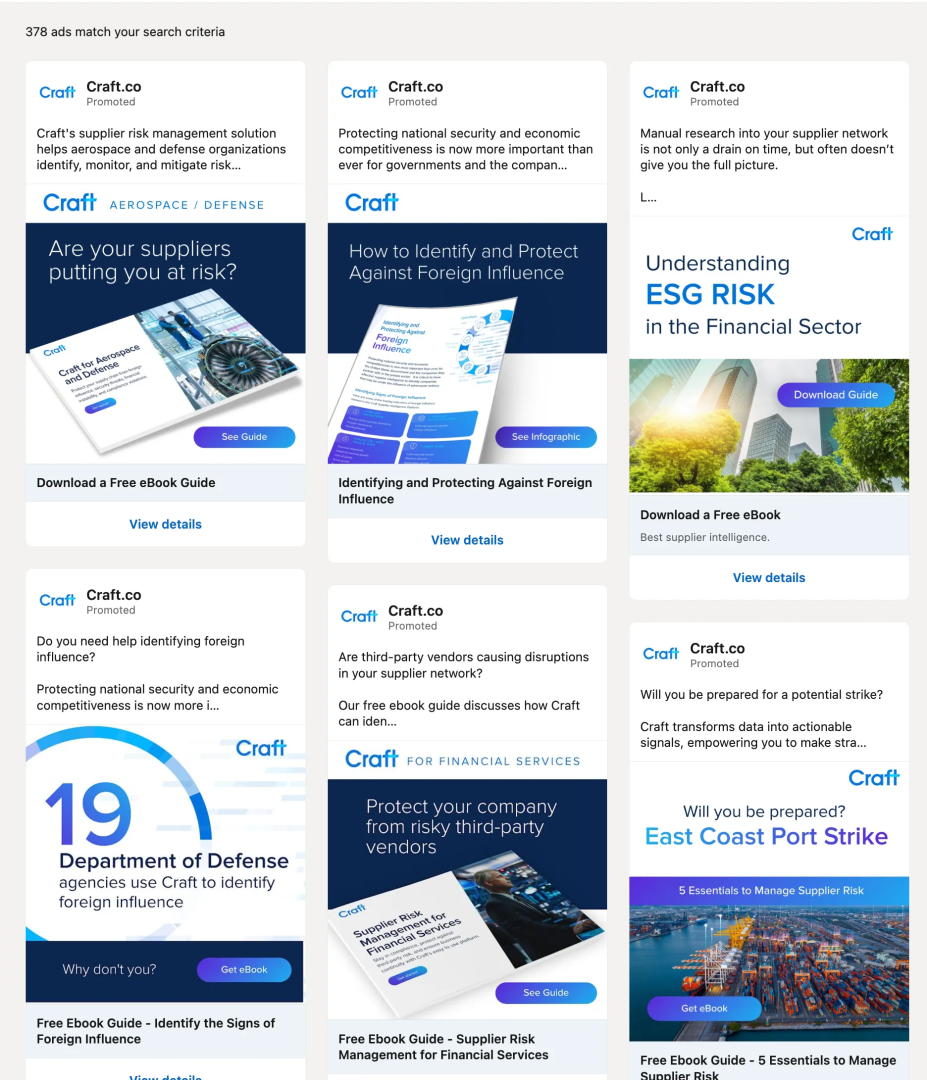
They are promoting their eBooks as the primary offer. This tactic aims to provide value upfront while capturing leads for further nurturing.
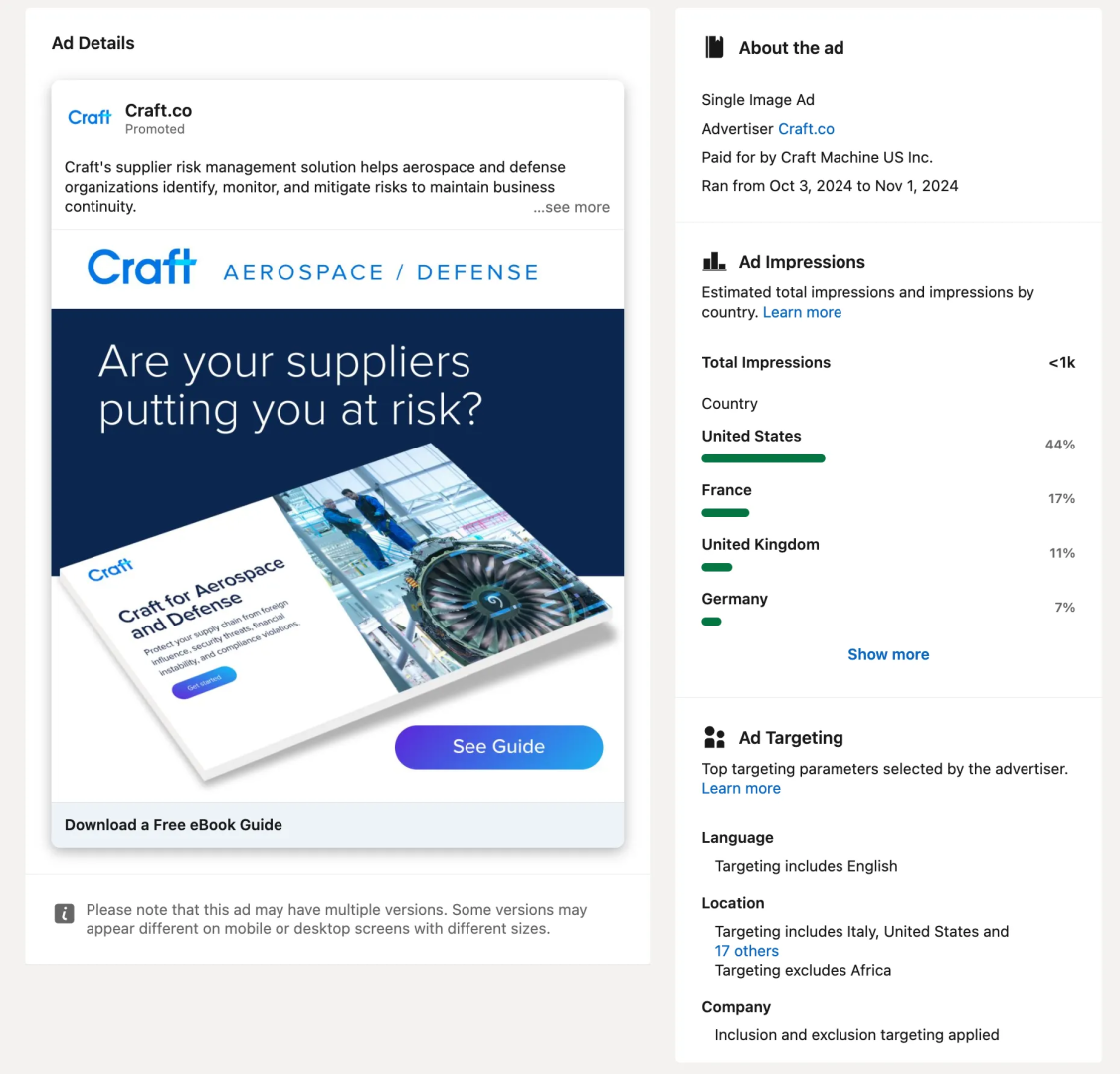
The ads target various sectors, such as: aerospace, defense, foreign affairs, and ESG, tailoring Craft.co’s messaging to the unique needs of different industries. This approach highlights the platform’s versatility and ability to address specific challenges across sectors.
The main call-to-action (CTA) used in these ads is to “Download a Free eBook Guide”. However, when clicking the ad, users are redirected to the Request a Demo landing page, as mentioned earlier.
While the eBook is technically free in terms of cost, users are required to provide their business email to access it, making it a valuable tool for capturing leads.
Other ads, like one directing users to the Resources page, give leads the option to choose which white paper or eBook they’d like to download. CTAs like “Download A Free eBook” continue to serve as effective entry points for lead generation, offering useful resources while collecting key contact information for follow-up.
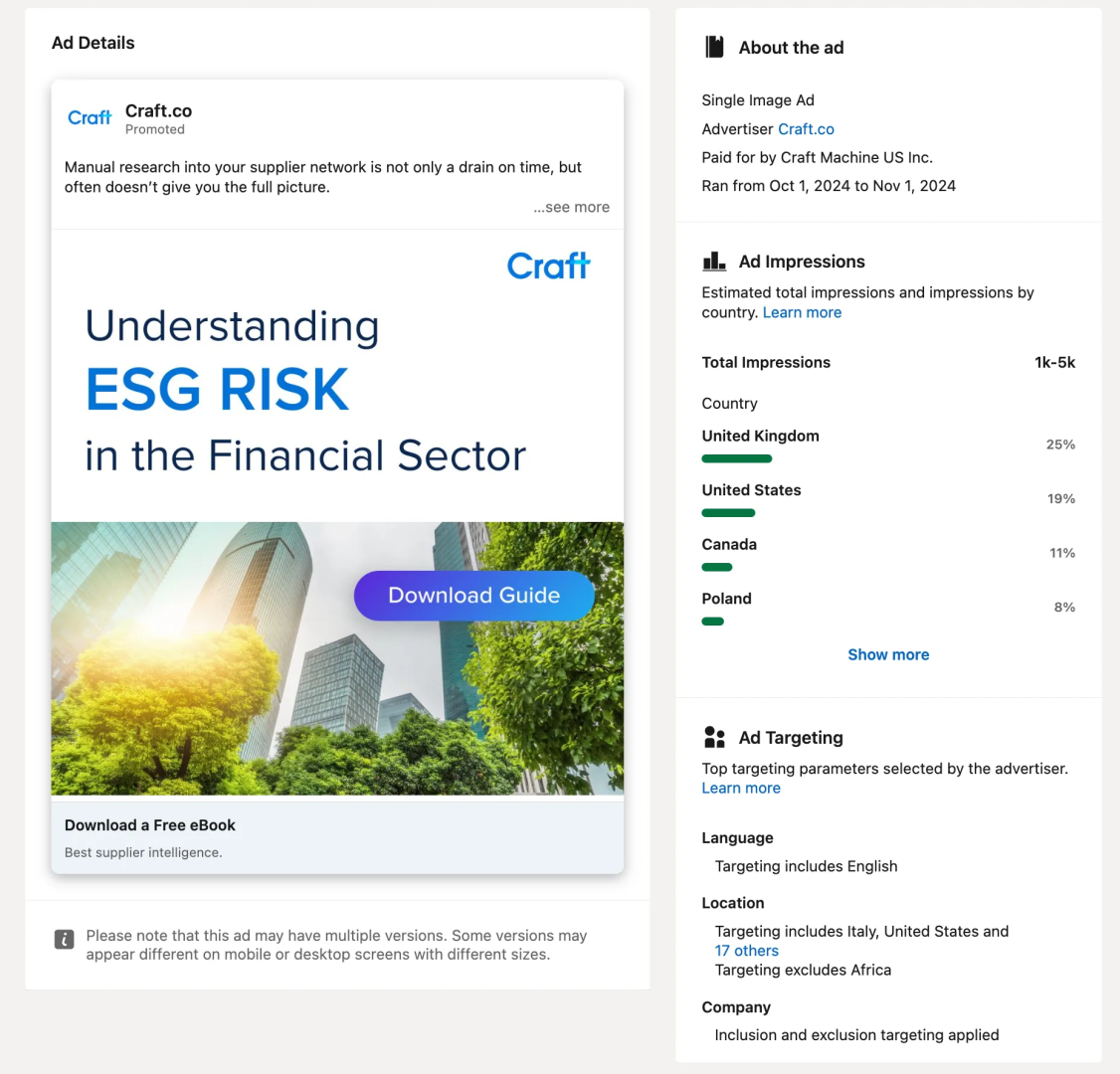
Some sort of conclusion
Craft.co is very focused on lead generation throughout its marketing efforts. From social media to gated content and email campaigns, the goal is clear: attract prospects, capture content information, and nurture leads. Their consistent blog and newsletter content offer valuable industry insights, but both could see greater impact if leadership amplified these channels more actively.
Ready to boost your own lead and demand generation? Let us craft the best strategies tailored to your goals, so you can focus on growing your business!
FAQs
1. What is craft.co and what market do they serve?
craft.co provides supplier and supply chain risk intelligence with AI-driven insights and collaboration tools for resilience across supplier networks.
2. Which social platform is primary for craft.co?
LinkedIn is their primary channel, with roughly 8k followers and frequent posts aimed at procurement and government stakeholders.
3. How often does craft.co post on LinkedIn and what engagement do they get?
About 13 posts per month. Typical engagement is modest, generally under 30 likes with few comments.
4. What content pillars show up most in their social activity?
Platform promotion, industry news with a risk lens, event promotion, press releases, and educational snippets—often driving to gated resources.
5. How do they convert social traffic into leads?
Most paths route to gated assets or forms. Requests for demos, risk assessments, solution briefs, white papers, ebooks, webinars, and a newsletter all require a business email.
6. What is the role of the newsletter in their funnel?
The newsletter is positioned as a lead magnet that promises timely supplier risk insights and is promoted across multiple site surfaces.
7. What do their paid campaigns promote?
They run LinkedIn campaigns by industry segment and largely promote ebooks that capture emails, sometimes redirecting to a demo request page.
8. What is the overall marketing pattern observed?
A lead-generation-heavy motion that concentrates on gated content and form fills, with room to grow executive-led thought leadership and community engagement.


